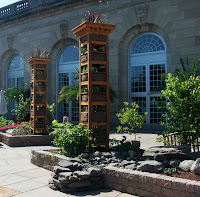When last I wrote of Paul Miskovsky, Betty and I were pulling plastic for a greenhouse in Falmouth – in the middle of January, with a wind chill down around zero degrees Kelvin. We recovered and went on to live a more or less normal life. This past week, I was again helping out Paul with a ‘little’ garden project.
The venue for this garden is the Newport Flower Show in Newport, Rhode Island. The Boston Flower & Garden Show (or, for that matter, the old New England Spring Flower Show) draws throngs of winter-weary visitors with the promise of a day’s worth of ersatz spring in the middle of March. In late June, by contrast, everything that can possibly be in bloom is in bloom. Why pay $25 to see flowers when they’re all around you?
One reason is that Newport is, well, Newport. The Vanderbilts and Astors may have decamped for other climes in some diaspora of the wealthy, but their mansions still line Bellevue Avenue, and it is the Newport Preservation Society that maintains that tangible legacy of the Gilded Age. All proceeds from the show go toward the ongoing restoration and maintenance of those mansions’ grounds.
Another reason is that the Preservation Society puts on a heck of a good show. I know a little bit about how flower shows are run, and Newport does a first-class job (except for the photography display, which is decidedly sub-par). If entertainment value is the ultimate pricing arbiter, Newport definitely delivers.
 |
| 10 a.m. Wednesday. That's Paul in the green shirt. |
At the aforementioned Boston flower shows, garden vignettes are the big draw (that first whiff of spring). At Newport, they’re a relatively recent addition and the gardens I remember from previous years tended to be heavy on cut stone and topiary and light on, well, ‘wow’ factor. Enter Paul Miskovsky. Paul is an über-landscaper, a guy who can take a kettle hole on Cape Cod and turn it into a horticultural fantasy land. Add David Haskell. Dave’s late father, Alan Haskell, was widely considered to be one of New England’s great horticulturalists. David is filling those large shoes quite admirably. Neither one had ever exhibited at Newport. This year, they did a joint entry.
 |
| The stone wall goes up... |
 |
| ... and gets a lavender garden |
There are three problems with doing a landscape garden at Newport. The first is time pressure. Trucks were allowed on the grounds mid-day Tuesday. The exhibits had to be ready for judging Friday morning. The Boston Flower & Garden Show provides a full four days for garden ‘builds’. Two and a half days isn’t a lot of time. The second problem is footprint. The Miskovsky/Haskell exhibit was allocated a 20’x40’ space. By the time I got to the build site on Wednesday morning, the dimension had already been ‘cheated’ out to 25’x50 feet. So, an 800 square foot vignette had been summarily enlarged to 1250 square feet, yet it still had to be built in the same time frame. The first photo shows what I saw when I arrived at 10 a.m. on Wednesday (except that the rocks were still in skids). To see these photos in greater detail, just double-click on them.
Which illustrates the third problem with Newport… the garden vignettes are all outdoors. Which means working at night is problematic. And, if it rains, things can really get messed up.
 |
| Thursday, 2 p.m., just before the deluge... |
 |
| Thursday, 4 p.m. The garden wasn't finished, but I was. |
Paul is a friend and working on his projects is very educational. Let me be very clear that no money changes hands in this, although I do get to eat as much pizza as I want. On Wednesday, we unloaded rocks, built a handsome rock wall around the perimeter of a massive purple beech, laid plywood to define the shape of the garden, mulched it all to a depth of two inches, positioned four lemon trees around the corners of the garden and then added bluestone to form the ‘patio’ of the exhibit. That was a full day’s work for eight people. I went home with a very sore back.
On Thursday, a crew of about 15 was on hand to build the garden. There were Master Gardeners eager to learn from two top-notch professionals, two knowledgeable crews blessed with terrific upper body strength... and me. We installed a wonderfully scented circle of lavender and cleome around the base of the beech and unloaded a 26-foot-long box truck filled to the brim with plant material. We spread yet more mulch. We built a kickboard.
Then, the heavens opened up (that third drawback to Newport). I’m not talking about a little rain. I’m talking Weather Channel red with spots of purple surrounded by yellow and deep, deep green.
 |
| Paul Miskovsky's and David Haskell's completed garden. |
The flower show opened to the public on Friday at noon, a photo of the finished garden is at left. Betty and I visited Paul's and David's garden Friday evening, where we found it being admired by a large crowd. Perhaps more telling, the exhibit was crowded inside. People were seated on the couches, engaged in animated conversations while the other exhibits with their formal gardens and metal chairs were deserted.
Working with Paul and David is an education, even if it will take a few weeks for my back to fully recover.
Working with Paul and David is an education, even if it will take a few weeks for my back to fully recover.














